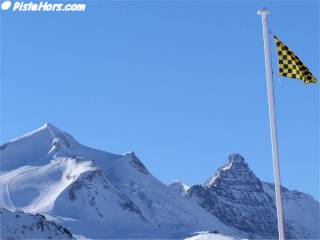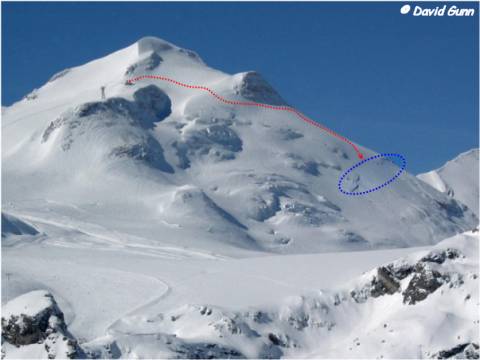
In April 2005 two young snowboarders, Sam Harber and James Rourke, were killed by a massive avalanche in the French Alps. More than four years on and the fallout from that slide is still reverberating far beyond the sparkling glaciers of the Savoie and carries an important warning for other off-piste enthusiasts.

Sam and James had just finished a hard season in Val d’Isere working for tour operator VIP Snowline. It was late afternoon when they took the lift towards the summit of the Grande Motte at Tignes. With 30cm of fresh snow the conditions were amongst the best of the season. Time for one last run, the north face of the mountain beckoned.
Due to its proximity to lifts the route is popular, and although not known for avalanches it is technically difficult[1]. The face is a maze of crevasses and ice walls. The two young men traversed high above these dangers and started their descent along the north-west shoulder. Half way down this face a slab avalanche measuring 500 meters wide and some 1.5 meters deep in places broke above them. Powerless to escape such a massive slide the boarders were carried 700 meters over a series of cliffs and buried deep under a mix of snow and ice.

The large rescue operation was hampered by failing light. James body was recovered the next day but Sam was only found at the end of June when the avalanche debris, some 10 meters deep in places, began to thaw. Both men were carrying avalanche beacons as well as rescue kit. The mayor of Tignes hired a private helicopter to assist with the search and rescue operation. With a minute in the air costing around 15 euros the final bill presented to the families, was ₤9,000 for helicopter costs and ₤1,200 for dog handlers for each victim .
VIP Snowline insures its season workers for ski accidents. In 2005 this was through CNA Insurance. CNA are an underwriter but if you have taken insurance through tour operators such as VIP Snowline and Inghams or through Fogg Travel you would have ultimately been covered by CNA.
CNA refused to meet the claim for rescue costs claiming that the danger was “reasonably foreseeable” and therefore not covered in the small print of their policy. It is this point that has angered the families of the two victims but were CNA correct in their judgement?
At the time the director of the Tignes Piste Service, Jean-Louis Tuaillon put the accident down to “bad luck” rather than a “particular error committed by the young men”. Mr Tuaillon is known as a straight talker with a deep understanding of the mountains and their dangers. He is a former director of the French Avalanche Research Institute (ANENA) and knows as much as anyone about avalanches.
However CNA may have been more interested in the reported conditions. The headline avalanche risk was Considerable (3/5), this alone is enough for many “off piste” insurers to reach for their umbrellas. It was fairly late on a fine spring day but at that altitude the face had probably remained cold. The men would have climbed a short distance to reach the route and passed danger signs. All pretty normal in the off-piste mecca of the Espace Killy.
For the families it is about showing that their sons were not reckless, disregarding safety advice for that one last run. The legal point turns around the “reasonably foreseeable danger”. Val d’Isere based avalanche expert Henry Schniewind has taken a particular interest in this case and asked Alain Duclos, an expert witness on avalanche incidents for the French courts, to investigate.
Alain points out that skiing at risk 3 is considered acceptable by both mountain professionals and recreational skiers. The avalanche risk scales are internationally agreed and have a very precise statistical base. Each risk level is based on observations on the terrain concerning the size and number of avalanches, how they were triggered, their altitude and slope aspect. In France, observers in ski resorts are vital for gathering this data which is why there are no full avalanche bulletins outside the ski season. This information is combined with weather predictions to produce the avalanche risk assessment.
Risk 3 means that skier triggered avalanches are probable but would be confined to certain routes and limited in size. Mr. Duclos argues that the Tignes avalanche was an event more in line with risk 4 or even 5 and therefore not foreseeable given the avalanche bulletin that was issued by the authorities. Henry says he was surprised that only a cursory investigation of events was carried out by the police and the insurance companies’ assessment was based on this report.
We talk a lot about avalanches on PisteHors. It’s normal as we are devoted to backcountry skiing in all its forms. It should be remembered that avalanches are the exception rather than the rule. That is what makes them so unpredictable. If there are any lessons to be learned it is to check the small print of your policy. If there are get-out clauses such as that in the CNA backed policies only ski off piste when the yellow flag is flying. If you are a serious tourer or off piste enthusiast get a proper insurance policy with no get-out clauses.
[1]A large part of the glacier collapsed last winter in a spectacular ice and snow slide. No-one was injured. Experts think this may be due to the snout of the glacier melting due to climate change which removes support for the ice higher up.
http://www.getoffpiste.com/sam-and-jamesa-tragic-accident-an-unjust-aftermathoverview-the-family-of-james-rourke-and-the-family-of-sam-harber-have.html
http://pistehors.com/news/ski/comments/british-boarders-killed-by-tignes-avalanche/
http://pistehors.com/news/ski/comments/mountain-of-debt-for-tignes-avalanche-families/